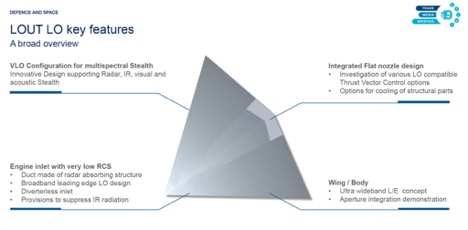Airbus Stealth Technology Demonstrator
Airbus has revealed a closely guarded secret project, a 12-metre wingspan stealth technology demonstrator
Dubbed LOUT – low observable UAV testbed – the aircraft is diamond-shaped and, so far, hasn’t flown. Airbus officials were very coy about when or whether it will ever fly, but the technologies developed for the flat grey painted four-tonne aircraft with few features visible beyond its distinctive shape, are expected to flow into future Airbus projects.
In a media reveal conducted at the Airbus facility at Manching in southern Germany, LOUT was revealed atop a stand within the giant anechoic chamber where it’s been tested for radio frequency and infrared signatures.
“I am convinced that we are at the cutting edge of low-observables and we as Airbus and Germany can make a significant contribution to the next generation fighter and carrier,” project head Mario Hertzog told visiting media.
The LOUT is the result of a project launched in 2010 and funded by Airbus and the German Ministry of Defence, with the work being performed at Manching and Bremen.
Airbus said they adopted a “‘skunk works’ approach” to LOUT’s development, a reference to the secretive Lockheed Martin advanced projects development division where the first practical stealth aircraft – the F-117A Nighthawk – was developed.
The LOUT project appears to have started with first principles, evaluating different configurations in 2D and 3D, including some with a more than passing resemblance to the F-117, but also to Northrop Grumman’s X-47A Pegasus UCAV demonstrator.
The current design is optimised to be least observable to a ground-based air defence system, using what Airbus says was a holistic approach to signature reduction in the radio frequency, infrared, acoustic and visible spectrum.
That used a combination of design, radar absorbent structures and low observable coatings. The engine outlet is a flat nozzle on the aircraft’s upper surface, and while air intakes were not visible on the demonstrator, renderings show two intakes on the upper surface behind the cockpit canopy.
Should it ever be weaponised, weapons would be carried internally. Airbus says this would be a subsonic aircraft powered by a conventional but unspecified jet engine.
So just how stealthy is LOUT? In the all important RF spectrum used by search and targeting radars, Airbus acknowledges significant signature reduction in the VHF through to Ka bands.
Mr Hertzog said they had also achieved signature reduction in the lower frequency, long wavelength HF band. Emerging HF radar systems can in theory see low observable aircraft configured to be least visible to radars with shorter wavelengths.
This article was published by ADBR on November 6, 2019.

